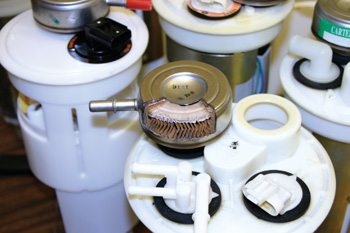Fuel pumps are a popular product line because virtually every vehicle built since the late 1980s and early 1990s have been equipped with some type of electronic fuel injection. A high-pressure electric pump is required to generate pressure so fuel will spray out of the fuel injectors when the injectors open. The amount of pressure the pump has to generate will vary depending on the application, but is typically in the 35 to 80 PSI range.
 Most original equipment electric fuel pumps are mounted inside the fuel tank. Submerging the pump in gasoline quiets the pump and allows the fuel to cool and lubricate the pump. This is very important because most electric fuel pumps spin at high speed (5,000 to 7,000 RPM or higher). Without a steady supply of fuel through the pump for cooling and lubrication, the pump can quickly self-destruct (a good reason to avoid running out of gas!).
Most original equipment electric fuel pumps are mounted inside the fuel tank. Submerging the pump in gasoline quiets the pump and allows the fuel to cool and lubricate the pump. This is very important because most electric fuel pumps spin at high speed (5,000 to 7,000 RPM or higher). Without a steady supply of fuel through the pump for cooling and lubrication, the pump can quickly self-destruct (a good reason to avoid running out of gas!).
The fuel pump is combined with the fuel level sending unit and float in the “fuel pump
module assembly,” which fits inside the tank through a hole in the top of the tank. The fuel pump assembly is held in place with fasteners or a lock ring, and sealed with a gasket or O-Ring. Replacing the pump module usually requires dropping the fuel tank.
The wiring and fuel line connections are on the outside of the tank. Corrosion and vibration can cause electrical problems with the wiring harness connection, which cause the pump to stop operating. Replacing the pump isn’t necessary because the problem is the voltage supply. A bad fuel pump relay, blown fuse, wiring fault or anti-theft system problem can also cause an electric fuel pump to stop working. It’s important to rule out all of these other possibilities before installing a new fuel pump to prevent unnecessary returns. If a newly installed fuel pump does not work, the problem wasn’t the pump but an electrical issue.
The fuel filter and fuel pump inlet sock must also be changed when a new fuel pump is installed. On returnless EFI applications, there is no in-line fuel filter. The filter and regulator are both part of the pump module assembly.
Electric fuel pumps also are used for other purposes — like transferring fuel from one tank to another in pickup trucks with dual fuel tanks. Some applications have two pumps, one to “lift” fuel out of the fuel tank and a second high-pressure pump to supply the fuel injectors.
Universal low-pressure electric fuel pumps also can be used to replace mechanical fuel pumps on older vehicles with carburetors. Mechanical fuel pumps are usually driven off the camshaft and use a spring-loaded diaphragm and a pair of valves to move fuel through the fuel line to the carburetor. Mechanical pumps operate at low pressure (2 to 7 PSI), and are prone to leaks, diaphragm failures and breakage. Replacing a mechanical pump with a low pressure universal electric pump can improve reliability and reduce the risk of vapor lock during hot weather by keeping the fuel in the line under pressure (which prevents the formation of vapor bubbles). Solid state electronic pumps have no bearings, electrical contacts or diaphragms to wear out or fail, which makes them more durable than other types of electric pumps. Installation only requires a voltage supply connection.
Other parts that may be needed when replacing or installing a fuel pump include fuel hose, clamps and a fuel filter. Fuel system cleaner should also be recommended to keep the fuel system and injectors clean. A dirty throttle body can be cleaned up with a can of aerosol throttle body cleaner.








